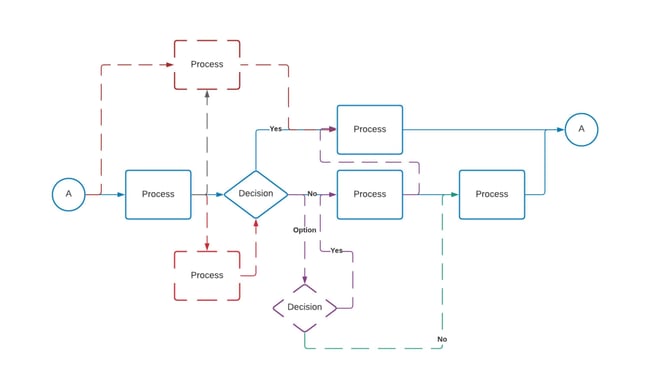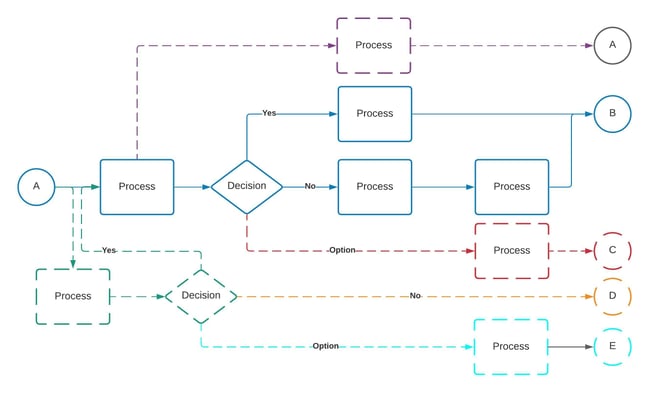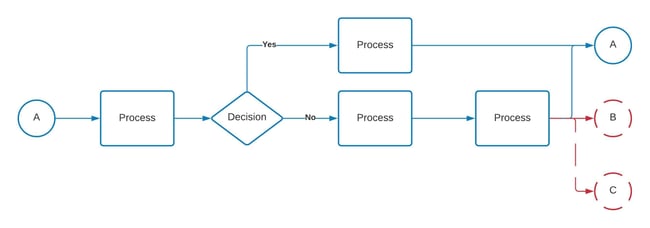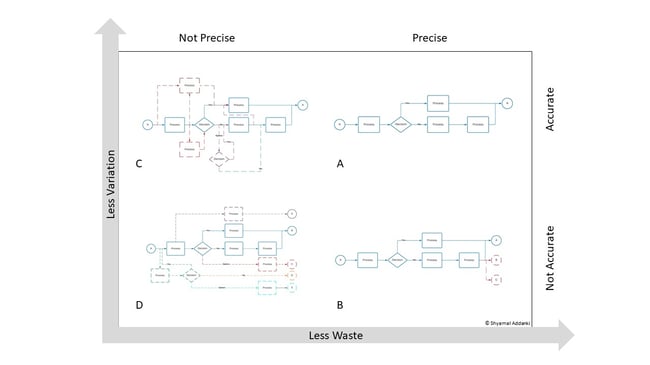










































Courtesy of SilverMist's, Shyamal Addanki wrote a synopsis of her speaking session discussing 'Process Risk Analysis for Digital Transformation'.
.png?width=300&name=BLOGS%20COMPANY%20LOGO%20(58).png)

.png?width=600&name=GTW%20-21%20DTW%20Speakers%20OnDemand%20(14).png) However, most companies (from my anecdotal experience in speaking with many CIOs and heads of digital transformation) do not take the time to study the processes they wish to transform. Rather, pilot project processes are usually chosen based on their failure to achieve expected outcomes, with the idea that Dx will change everything. With this line of thinking, a poorly-performing process (i.e. inefficient, uncontrolled) is digitized and automated as a pilot project and everyone is shocked when the improvement is sub-par when, in fact, this should be expected.
However, most companies (from my anecdotal experience in speaking with many CIOs and heads of digital transformation) do not take the time to study the processes they wish to transform. Rather, pilot project processes are usually chosen based on their failure to achieve expected outcomes, with the idea that Dx will change everything. With this line of thinking, a poorly-performing process (i.e. inefficient, uncontrolled) is digitized and automated as a pilot project and everyone is shocked when the improvement is sub-par when, in fact, this should be expected. What companies ought to do is perform PRA on their key processes (if not all of them). This will provide a much better idea of the right candidates for Dx pilot projects. It isn't always going to be the poor performers. In fact, I would argue that the real value of Dx should be clearly obvious when a well-operating manual/paper process is digitized.
What companies ought to do is perform PRA on their key processes (if not all of them). This will provide a much better idea of the right candidates for Dx pilot projects. It isn't always going to be the poor performers. In fact, I would argue that the real value of Dx should be clearly obvious when a well-operating manual/paper process is digitized.  Process Lifecycle
Process Lifecycle Process Accuracy and Precision
Process Accuracy and Precision This process is precise, as in users follow the documented steps correctly, but NOT accurate, meaning there are more outcomes possible than what is documented.This process is precise, as in users follow the documented steps correctly, but NOT accurate, meaning there are more outcomes possible than what is documented.
This process is precise, as in users follow the documented steps correctly, but NOT accurate, meaning there are more outcomes possible than what is documented.This process is precise, as in users follow the documented steps correctly, but NOT accurate, meaning there are more outcomes possible than what is documented. D: This process needs definition, and user training. Do not try to automate such a process until it has moved into quadrant A.
D: This process needs definition, and user training. Do not try to automate such a process until it has moved into quadrant A.
 Shyamal Addanki,
Shyamal Addanki,
Principal,
Silvermist Consulting.

View our schedule of industry leading free to attend virtual conferences. Each a premier gathering of industry thought leaders and experts sharing key solutions to current challenges.
View Schedule of EventsWelcome to BTOES Insights, the content portal for Business Transformation & Operational Excellence opinions, reports & news.
-------------------------------------------------------
Search for anything
Insights from the most progressive thought leaders delivered to your inbox.
Insights from the world's foremost thought leaders delivered to your inbox.
Being a hero is all about creating value for others. Please invite up to 5 people in your network to attend this premier virtual conference, and they will receive an invitation to attend.
If it’s easier for you, please enter your email address below, and click the button, and we will send you the invitation email that you can forward to relevant people in your network.
View our schedule of industry leading free to attend virtual conferences. Each a premier gathering of industry thought leaders and experts sharing key solutions to current challenges.
View Schedule of EventsWatch On-Demand Recording - Access all sessions from progressive thought leaders free of charge from our industry leading virtual conferences.
Watch On-Demand Recordings For FreeDelivered by the industry's most progressive thought leaders from the world's top brands. Start learning today!
View All Courses NowThe premier Business Transformation & Operational Excellence Conference. Watch sessions on-demand for free. Use code: BFH1120
Watch On-DemandInsights from the most progressive thought leaders delivered to your inbox.
Insights from the world's foremost thought leaders delivered to your inbox.
Being a hero is all about creating value for others. Please invite up to 5 people in your network to also access our newsletter. They will receive an invitation and an option to subscribe.
If it’s easier for you, please enter your email address below, and click the button, and we will send you the invitation email that you can forward to relevant people in your network.
Courtesy of Nintex Pty's Paul Hsu, below is a transcript of his speaking session on 'Improve employee productivity during and post-COVID by ...
Read this article about HP, Best Achievement in Operational Excellence to deliver Digital Transformation, selected by the independent judging panel, ...
Read this article about BMO Financial Group, one of our finalists, in the category Best Achievement in Operational Excellence to deliver Digital ...
Read this article about Cisco, one of our finalists, in the category Best Achievement of Operational Excellence in Internet, Education, Media & ...









































































































































































































